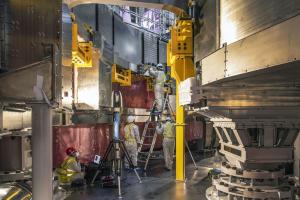Adjusting a correction coil's position
Facing similar constraints, a third kidney-shaped bottom correction coil (BCC/6) was successfully installed on 5 January. Workers from the CNPE Consortium (Tokamak assembly contractor TAC/1) are seen here carrying out metrology measurements and adjusting the coil's position on its yellow temporary supports (final positioning will be possible only when all vacuum vessel modules are in place). A fourth bottom correction coil (BCC/3) is scheduled for installation this week, while the full set of six should be in place by the end of February.


